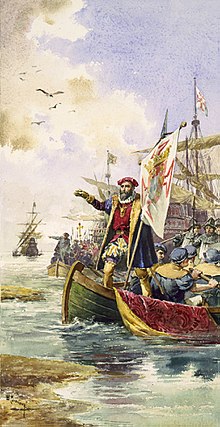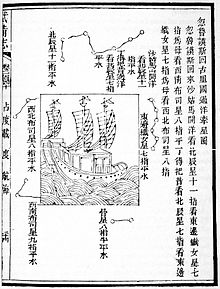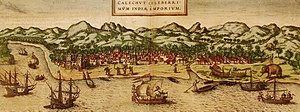Calicut (kingdom)

The Kingdom of Kozhikode (
Foundation



The ancient port of
During the
The rise of Calicut as a major trading centre and a port city does not seem to have happened before the 13th century. The
According to the
There is some ambiguity regarding the exact course of events that led to the establishment of the

However,
However, the Eradis
With the conquest of Polanad, the status of the Utayavar (Governor) increased and he came to be known as Swami Nambiyathiri Thirumulpad and the Kingdom of Calicut also came to known as Nediyiruppu Swarupam after the original house of the Eradis at Nediyiruppu. The king's title gradually evolved into Samoothirippadu or
In the 14th century, Kozhikode conquered larger parts of central Kerala after the seize of Tirunavaya region from Valluvanad, which were under the control of the king of Perumbadappu Swaroopam (Cochin). The ruler of Perumpadappu was forced to shift his capital (c. CE 1405) further south from Kodungallur to Kochi. In the 15th century, the status of Cochin was reduced to a vassal state of Kozhikode, thus leading to the emergence of Kozhikode as the most powerful kingdom in medieval Malabar Coast.[3]
The history of Kozhikode can roughly be divided into several periods marked by a few epoch-making events. These include the city's establishment, the arrival of the Portuguese, the arrival of the Dutch, the Mysorean Invasion, the rise of British Power, the beginning of the
Society and Organization
According to the Chinese traveler Ma Huan, who describes visiting Calicut in the Yingya Shenglan, Calicut was a place with relative harmony between its Hindu and Muslim populations, with a Hindu king making compact with Muslim lords to refrain from eating pork (per Islamic dietary laws), so long as they did not eat beef. Huan also described worship of Moses existing in addition to Islam and Hinduism, which Huan mistakenly identified as Buddhism. Additionally detailed was the existence of a complex system of measurements for trade, as well as a system of succession in which the king's sister's son inherited the throne, due to a belief that legal family only constituted those born from a woman within said family; if no such heir existed, the throne would be passed to "some man of merit."[20]
Arrival of the Portuguese

This single event marked an epoch in the history of Kerala and India, not because Vasco da Gama discovered the sea route to India (the Chinese, the Arab and Turkish sultanates, and the African kingdoms already traded directly with India) but, unlike the others, the Portuguese yearned for political power and imperial domination. Vasco da Gama's fame is more often argued as due to historical reasons for which he was hardly responsible[21] in that he was accompanied by a Portuguese-speaking Arab merchant provided by the Sultan of Melinda in East Africa. Vasco da Gama was sent by King Manuel I and landed in Calicut at Kappad in 17 May 1498.[22] Following the discovery of a sea route from Europe to Malabar in 1498, the Portuguese began to expand their territories and ruled the seas between Ormus and the Malabar Coast and south to Ceylon.[23][24] The navigator was received with traditional hospitality, but an interview with the Zamorin failed to produce any concrete results. Vasco da Gama's request for permission to leave a factor behind him in charge of the merchandise he could not sell was declined by the King, who insisted that da Gama pay customs duty like any other trader, straining the relationship between the two. The next expedition was sent by the King of Portugal under the leadership of Pedro Álvares Cabral in 1500. His agent secured a settlement to erect a factory at Calicut. This, however, precipitated matters between the Arabs and the Portuguese. The Portuguese capture of Arab vessels and ensuing massacre was retaliated by the locals who burned down the factory and butchered half of the Portuguese on land. Cabral sailed for Cochin, where he was cordially received and allowed to load his ships. Vasco da Gama reached Calicut the second time with 15 ships and 800 men in February 1502. In January 1502, the First Battle of Cannanore between the Third Portuguese Armada and Kingdom of Cochin under João da Nova and Zamorin of Kozhikode's navy marked the beginning of Portuguese conflicts in the Indian Ocean. When da Gama's call to expel all Muslims from Calicut was vehemently turned down, he bombarded the city and captured several rice vessels, cutting off the crew's hands, ears, and noses.

With rising bonhomie between the Maharaja of Cochin and the Portuguese, there followed several wars in which the Portuguese propped up Cochin and Cannanore against the Zamorin. Scores of men perished in these wars on all sides starting in 1503 and continuing till the early 1570s. In February 1509, the defeat of the joint fleet of the
In 1503, the Portuguese had built a fort in Chaliyam with the consent of the Raja of the Kingdom of Tanur (Vettattnad) from where they re-established supremacy over Indian waters. It provided the Portuguese ample opportunities to harass the Zamorin and enter the heart of his kingdom in the event of war. The Chaliyam fort was 'like a pistol held at the Zamorin's throat'. The Zamorin attacked Chaliyam and recaptured the fort in 1571 coinciding with the defeat of the ruler of Vijayanagara, an ally of the Portuguese. The Portuguese were forced to abandon the fort, which was then completely demolished. The fall of Chaliyam fort marked the beginning of the end for the Portuguese in the great game of the East. The Portuguese approached the Zamorin again in 1578 for reconciliation. By 1588 they were settled in Calicut and in 1591 built a church on land donated by the Zamorin (who even laid the foundation stone). The Zamorin's growing friendship was nevertheless a result of his gradual estrangement with the Kunjali Marakkars.
By 1663, the Portuguese flag ceased to fly in Kerala as the Dutch arrived at the scene and captured all their strongholds of Quilon, Cranganore, Purakkadm, Cochin and Cannanore.
Arrival of the Dutch
In 1602, the Zamorin sent messages to Aceh promising the Dutch a fort at Kozhikode if they would come and trade there. Two factors, Hans de Wolff and Lafer, were sent on an Asian ship from Aceh, but the two were captured by the chief of Tanur, and handed over to the Portuguese.[25] A Dutch fleet under Admiral Steven van der Hagen arrived at Kozhikode in November 1604. It marked the beginning of the Dutch presence in Kerala and they concluded a treaty with Kozhikode on 11 November 1604, which was also the first treaty that the Dutch East India Company made with an Indian ruler.[7] By this time the kingdom and the port of Kozhikode was much reduced in importance.[25] The treaty provided for a mutual alliance between the two to expel the Portuguese from Malabar. In return the Dutch East India Company was given facilities for trade at Kozhikode and Ponnani, including spacious storehouses.[25] It provided for a mutual alliance between the Zamorin and the Dutch to expel the Portuguese from Indian soil. In return, they were given facilities for trade at Calicut, including spacious storehouses. In the 18th century the Dutch position weakened and they were forced to surrender to a British force that marched from Calicut to Cochin on 20 October 1795 (as part of the larger Napoleonic Wars between Holland and England in Europe). Travancore became the most dominant state in Kerala by defeating the powerful Zamorin of Kozhikode in the battle of Purakkad in 1755.[26]
The Mysore invasions
Hyder Ali ascended the throne of Mysore in 1761. By 1764, he obtained a pledge of neutrality from the British at

British domination

The arrival of
National movement
The city also witnessed several movements as part of the struggle for Indian independence from the British. A conference of the Congress was held at Calicut in 1904 with C. Vijayaraghavachariar in the chair. A branch of the
After Indian Independence in 1947, Madras Presidency was renamed the
See also
- Saamoothiri
References
- ^ "Lectures 26–27". Purdue University. Archived from the original on 16 July 2009. Retrieved 23 September 2009.
- ^ The Portuguese, Indian Ocean and European Bridgeheads 1500–1800. Festschrift in Honour of Prof. K. S. Mathew (2001). Edited by: Pius Malekandathil and T. Jamal Mohammed. Fundacoa Oriente. Institute for Research in Social Sciences and Humanities of MESHAR (Kerala).
- ^ ISBN 978-81-264-1588-5. Archivedfrom the original on 13 November 2021. Retrieved 19 July 2020.
- ^ ISBN 9788126415786.
- ^ Coastal Histories: Society and Ecology in Pre-modern India, Yogesh Sharma, Primus Books 2010
- ^ Gurukkal, R., & Whittaker, D. (2001). In search of Muziris. Journal of Roman Archaeology, 14, 334–350.
- ^ ISBN 978-81-264-1588-5. Archivedfrom the original on 13 November 2021. Retrieved 19 July 2020.
- ^ According to Pliny the Elder, goods from India were sold in the Empire at 100 times their original purchase price. See [1]
- ^ Bostock, John (1855). "26 (Voyages to India)". Pliny the Elder, The Natural History. London: Taylor and Francis.
- ^ Indicopleustes, Cosmas (1897). Christian Topography. 11. United Kingdom: The Tertullian Project. pp. 358–373.
- ^ Das, Santosh Kumar (2006). The Economic History of Ancient India. Genesis Publishing Pvt Ltd. p. 301.
- ^ a b c K. V. Krishna Iyer (1938). Zamorins of Calicut: From the earliest times to AD 1806. Norman Printing Bureau, Kozhikode.
- ^ Ayyar, K.V. Krishna, The Zamorins of Calicut- From the Earliest Times to A.D.1806(1938), Calicut.
- ^ M.G.S. Narayanan,Calicut: The City of Truth(2006) Calicut University Publications
- ^ Sreedhara Menon.A,A Survey of Kerala History(1967),p.152. D.C.Books Kottayam
- ^ Bhāratīya sthalanāma patrikā (page 44) published by Place Names Society of India
- ^ Sewell, Robert (1884). Lists of inscriptions, and sketch of the dynasties of southern India. E. Keys at the Government Press. p. 197.
The Zamorin made Menokki ruler of Porallatiri and came to terms with the troops and people. After this follows an account of the founding of the town of Calicut, close to the Zamorin's palace at Tali
- ISBN 978-81-7748-000-9. Archivedfrom the original on 14 April 2023. Retrieved 22 September 2016.
- ^ Divakaran, Kattakada (2005). Kerala Sanchaaram. Trivandrum: Z Library.
- ^ Ma Huan, "Ying-Yai Sheng-Lang," pages 138-146.
- ^ Panickar.K.M, A History of Kerala(1959) Annamalai University
- ^ "Portuguese (1505–1961)". myeduphilic. Archived from the original on 7 November 2017. Retrieved 5 November 2017.
- ^ Sanjay Subrahmanyam, The Career and Legend of Vasco da Gama, Cambridge University Press, 1997, 288
- ^ Knox, Robert (1681). An Historical Relation of the Island Ceylon. London: Reprint. Asian Educational Services. pp. 19–47.
- ^ a b c Sanjay Subrahmanyam. "The Political Economy of Commerce: Southern India 1500–1650". Cambridge University Press, 2002
- ^ Shungoony Menon, P. (1878). A History of Travancore from the Earliest Times (pdf). Madras: Higgin Botham & Co. pp. 162–164. Retrieved 5 May 2016.
- ^ Pamela Nightingale, ‘Jonathan Duncan (bap. 1756, d. 1811)’, Oxford Dictionary of National Biography, Oxford University Press, 2004; online edn, May 2009
- ^ "CHRONOLOGICAL LIST OF CENTRAL ACTS (Updated up to 17-10-2014)". Lawmin.nic.in. Archived from the original on 7 January 2018. Retrieved 7 August 2016.
- ^ Lewis McIver, G. Stokes (1883). Imperial Census of 1881 Operations and Results in the Presidency of Madras ((Vol II) ed.). Madras: E.Keys at the Government Press. p. 444. Archived from the original on 27 March 2023. Retrieved 5 December 2020.
- ^ Presidency, Madras (India (1915). Madras District Gazetteers, Statistical Appendix For Malabar District (Vol.2 ed.). Madras: The Superintendent, Government Press. p. 20. Archived from the original on 27 March 2023. Retrieved 2 December 2020.
- ^ HENRY FROWDE, M.A., Imperial Gazetteer of India (1908–1909). Imperial Gazetteer of India (New ed.). Oxford: Clarendon Press. Archived from the original on 16 December 2008. Retrieved 2 December 2020.
Further reading
- K. V. Krishna Iyer (1938), Zamorins of Calicut: From the earliest times to AD 1806, Norman Printing Bureau, Kozhikode
- M. G. S. Narayanan, Calicut: The City of Truth Revisited Kerala. University of Calicut, 2006
- A. Sreedhara Menon, A Survey of Kerala History, (1967), Madras, 1991
- S. Muhammad Hussain Nainar (1942), Tuhfat-al-Mujahidin: An Historical Work in The Arabic Language, University of Madras, retrieved 3 December 2020 (The English translation of the historic book Tuhfat Ul Mujahideen written about the society of Kozhikode by Zainuddin Makhdoom II during sixteenth century CE)

